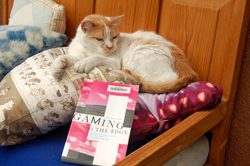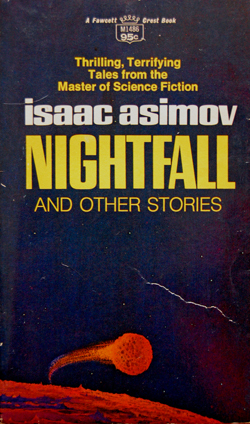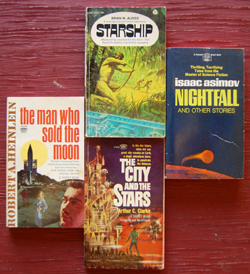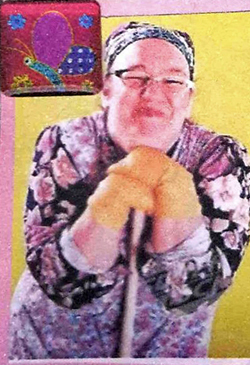Jane Lindskold's Blog, page 109
April 27, 2016
Bugs Just Wanna Be Plants
This past Sunday, Jim and I went (along with our friends Michael and Chip) to the Botanical Gardens. Our specific goal was to see the new Bugarium, an enclosed display featuring various kinds of insects. The Bugarium offered a really interesting selection, including local insects most people never see, as well as various exotic selections from around the globe. The displays included both subterranean and subaqueous types.

Walking Stick Revealed!
Additionally, besides the daylight section, there was a small but well-arranged jungle-at-night exhibit.
Not all of the insects were locked behind glass. The leafcutter ants had an enclosure (surrounded by water, to keep them in) that extended up to the ceiling where an artificial vine enabled them to carry off their finds – on the day we were visiting, they had miniature roses, as well as leaves – to their nest.
Another “open” exhibit was a small outside pond, alongside which was a sign discussing the various types of dragonflies that one might see. Jim and I particularly enjoyed this because our own small pond attracts at least three different types of dragonflies and now we could put names to them.
The Bugarium featured a great deal of educational material, but managed to make learning about bugs fun. I very much enjoyed the hand puppet selection, including the very large spider that used all five fingers to create some realistic spidery motions.
In the name of diversity – or maybe only available display space – the Bugarium included one non-insect exhibit. These were the naked mole rats from the Zoo (which is the Botanical Garden’s sibling within the Biopark system). Naked mole rats have never been on my “favorites list.” In fact, if asked if I wanted to hold a tarantula or a naked mole rat, I’d opt for the spider.
Ridiculous reaction, I know, especially for someone who, in general, likes rodents. I don’t think my reaction to the naked mole rats is due so much the naked part, as the squinched up eyes. Even when in a luxurious enclosure with plenty of food, the naked mole rats always just look uncomfortable…
By contrast, many of the insects appeared positively smug, especially those who specialized in various sorts of camouflage. The Bugarium offered a wide variety of “walking stick” insects. These came in shades from dark brown to pale green. Most were rather twiggy, but a couple gave the impression of having bark.
I was interested to learn that the praying mantis family includes – in addition to the sleek green creatures I am familiar with from my yard – a wide range of colors. There were even some dark brown types with rough protrusions that looked as if they had bark. These were hard enough to find in a small tank. If they’d been on the trunk of a tree, they’d have been completely invisible.
I didn’t write down the name of my favorite insect of the day, but it was called something like a “walking leaf.” As with the walking stick insects, these insects had decided that the best way to get through life was to look very much like what they were not. These didn’t stop with looking like a cluster of green leaves, they’d taken the art of camouflage to the point that some of the “leaves” were “nibbled” or “browning” around the edges, just like natural leaves.
Very cool!
Although visiting the Bugarium had been our main reason for going to the Botanical Gardens, we did walk around the entire facility. We’ve been going to the facility since it opened, but one of the great things about gardens is how they change from year to year, even without anything “new” being added.
The Bugarium was this year’s new exhibit, but we enjoyed seeing how well last year’s new addition – the desert rose garden – is developing. Last year it looked more like a construction site with some pathetic rose plants dotted around it. This year it promises to start developing. Definitely a return is in order later this summer.
We finished by visiting the aquarium. It’s small but choice. The big tanks include various types of sharks, rays, and even a couple of sea turtles. The smaller exhibits include sea horses, squid, and jellyfish. My personal favorite were some blue jellyfish with light yellow dots. They looked more like swimming mushrooms than anything aquatic.
I was delighted to read that our Botanical Gardens have begun to get national attention, having been chosen by several travel sites as worth making the trip to visit. Pretty nice having them within a short drive from my own home.
Now… Time to go see the zoo. I hear the new carousel is open and I love carousels!
But first, a mystery trip. If all goes well, I’ll be telling you about that next week.


April 22, 2016
FF: Creativity Takes Many Forms
The title says it all…
For those of you just discovering this feature, the Friday Fragments lists what I’ve read over the past week. Most of the time I don’t include details of either short fiction (unless part of a book-length collection) or magazine articles.

Sun, Book, Pillows: What More Could a Cat Want?
The Fragments are not meant to be a recommendation list. If you’re interested in a not-at-all-inclusive recommendation list, you can look on my website under Neat Stuff.
Once again, this is not a book review column. It’s just a list with, maybe, a bit of description or a few opinions tossed in.
Recently Completed:
Gaming at the Edge: Sexuality and Gender at the Margins of Gamer Culture by Adrienne Shaw. “Gamer” here means video, not RPG. Interesting, but dense. Although academic jargon periodically got in the way of clarity, in the end, it was worth the read.
Who Am I? Pete Townsend. Audiobook. Read by Pete Townsend. Townsend’s thoughtful, incisive view of his own struggles to realize complex artistic visions – despite some seriously self-destructive behaviors – is interesting. His reading is quite good and means that the text is his own, not “interpreted” by a reader. This is a huge bonus for autobiography.
The Unfairest of Them All (Ever After High #2) by Shannon Hale. Between the above and my own crazy workweek, I really needed some lighter reading. But even in this setting, Hale manages to slide in some serious commentary on when right is wrong and wrong is right.
In Progress:
A Wonderlandful World (Ever After High #3) by Shannon Hale.
The Great Mythologies of the World volume one in the Great Courses series. Audio. Sometimes, even with a subject I know a lot about, I enjoy someone else’s point of view.
Also:
Let’s just say I’ve been doing a lot of reading of my own material and leave it there.


April 21, 2016
TT: Old Styling in SF
JANE: When I was a junior in high school, my English teacher, Mrs. McCabe, created a very interesting assignment. She divided the class into group, then randomly assigned novels to each group. Each group was to prepare a presentation on the novel to give before the class. Who was to do what element of the novel was also assigned randomly. I still recall my reaction when I looked at the word printed on my slip of paper. It was Style.

Let’s Take a Closer Look
“What?” thought I, “is ‘Style’? How can I ever hope to discuss this, especially in a book like Vanity Fair?”
I usually did very well in English, but I thought I might fail this assignment.
ALAN: What did you do?
JANE: I looked Style up in the dictionary. Then I forged onward. And, for those of you who are waiting in trepidation, I did not fail the assignment. Indeed, I learned a lot.
But I don’t bring this up just to provide a window into a past anxiety. If we’re going to discuss “Style” in SF/F, I think it would be a good idea if we start by providing ourselves with a working definition, so we end up talking about the same thing.
I’d love to hear what springs to mind for you when someone talks about the “Style” of a novel or writer or even time period.
ALAN: Mainly I think it’s the way that sentences are put together. Hemingway’s short, declarative sentences are instantly identifiable. At the other extreme you have Henry James with his long, rambling sentences that are absolutely stuffed to the gills with subordinate within subordinate clauses. And let’s not forget Damon Runyon with his utterly inspired use of the historical present tense.
After that things start to get a bit more subtle. Raymond Chandler’s very clever and often witty similes (…as false as an usherette’s eyebrows…) are quite distinctive, as is the stream of consciousness technique used by Virginia Woolf and James Joyce that tries to mimic people’s interior thoughts.
In a nutshell, for me, style is defined by the structure of the prose. How did you approach the problem when you set out to analyse Vanity Fair?
JANE: I can’t really remember. This was, after all, decades ago. So what I remember most was the apprehension I felt about having to deal in a concrete fashion with a term that people tend to toss around lightly. “I like that writer’s style” can mean different things to different people.
That’s why I wanted to have some idea of what you meant before we dove into the difficult question of “style” in SF and, particularly, the thorny issue you mentioned last week. I quote: “Another criticism I’ve heard about the [SF/F] classics is that the writing style can sometimes seem cumbersome and old fashioned.”
So, what sort of things do people mention when they criticize the style?
ALAN: That’s hard to answer – I’ve not seen any specifics, mostly I’ve just seen general grumbling about old-fashioned and clunky.
But one example that I have seen mentioned is Isaac Asimov’s short story “Nightfall.” It’s been voted the best SF story ever in numerous polls, but if you actually go and read it you’ll find that it reads like it was written by a teenager who was still trying to learn how to write properly. And that’s because it was written by a teenager who was still trying to learn how to write properly. In one of his several autobiographies, Asimov said that he always found it a bit embarrassing that such a badly written story was held in such reverence. It has a great central idea, but the story itself is very poorly written.
JANE: Okay… I went and re-read “Nightfall” (published 1941), then, for good measure I re-read Stanley G. Weinbaum’s “A Martian Odyssey” (published in 1934). This gave me what may be a valid insight into what could be called the “style” or expectations of fiction at that time. This is different from personal writerly style, but no less valid.
Both of these stories can be found in The Science Fiction Hall of Fame. This collection itself is probably now considered a dinosaur, since it was published in 1970 – a walloping forty-six years ago or, to put it all into perspective, a greater interval than between the publication of the anthology and the oldest story in the volume
With me so far?
ALAN: Indeed I am. What conclusions did you draw from this?
JANE: For one thing, I was struck by the fact that both stories (and, indeed, others in the collection) were essentially about events that had already mostly happened. In other words, they broke a cardinal tenant of modern writing: “Show Don’t Tell.”
As such, these stories were incredibly talky, with stereotypical characters whose names – to use “Nightfall” as an example – could have been replaced with “Reporter,” “Psychologist,” “Chief Astronomer,” “Cultist” without losing a beat. The talky characters talk to each other, then the story ends.
“Nightfall” essentially has two parallel plots, both talky: one talking about past events that lead to the current situation; the other talking about the current situation (the impending “Darkness”) and what might happen. The story ends with a shift to an omniscient narrative voice that informs us (in the best radio voiceover manner) “The long night had come again.”
As such, I can see why a post-television audience, accustomed to being shown not told, would find this deadly. However, I think there’s a bigger element influencing the style here than visual versus auditory storytelling. Want to guess what it is?
ALAN: No idea.
JANE: Wrong! Quite the opposite. Idea is really what the stories are all about!
My long-ago English teacher, Mrs. McCabe, would have broken the elements of a story into plot, setting, characters, and style. But for SF, especially “hard” SF, the concept that the IDEA is the hero is crucial.
“Nightfall” begins with a quotation from Emerson.
“If the stars should appear one night in a thousand years, how would men believe and adore, and preserve for many generations the remembrance of the city of God?”
Asimov’s story takes Emerson’s idea and provides a very different answer. Along the way, he designs a complicated solar system that justifies the idea of a relatively sophisticated civilization that has no idea the universe is larger than eight light years, and within which the residents of the planet are accustomed to always having at least some light.
ALAN: Ah! A penny just dropped in my head. Style is more than just sentence structure and word choice. It’s also the way in which the story itself is put together.
JANE: Exactly! When I thought about it, I realized that if retold as a novel, “Nightfall” could be very gripping. Instead being set on the final day, we’d start a few weeks earlier. The characters would be given dimension. There would be trauma and tears over who would go into the “Hideout.” We’d have separated lovers, battles in the streets, as well as the build up to the final disaster… And maybe some of our protagonists (because we’d have some, rather than talking heads) would survive the initial disaster.
Then we could have interminable sequels about how the survivors deal with the “long night.” Actually, handled correctly (say by S.M. Stirling) as retold, “Nightfall” could be quite gripping.
ALAN: As it happens, Robert Silverberg spotted that before you did and he expanded the story into a novel (also called Nightfall) in 1990. Apart from the lack of sequels, he follows your plot outline quite well.
JANE: I had no idea! I wish you could hear how loud I’m laughing.
As I see it, one of the difficulties older SF has with reaching a modern audience is that in a genre now dominated not only by novels, but by series, readers don’t just want a Cool Idea and a setting that exists as an excuse to show it off, they want developed characters, intricate plot, and good prose.
ALAN: I think you’ve hit the nail on the head. The older stories could well seem unsophisticated to modern readers, and that can be quite a turnoff.
JANE: I’d actually like to look more closely at the prose conventions of the older SF and how they inform the style. I’ve had some cool thoughts… But I also want to go write, so can we wait until next time?


April 20, 2016
D is for Deadline
A few weeks ago, when I was the Featured Speaker at the UNM Writer’s Conference, part of my talk was about how important it is to establish writing habits. I went out of my way to explain that there isn’t one way to do this. I then supplied examples from several professional writers (including myself, from back when I was getting started) who manage to produce a regular flow of novels and short fiction despite holding down full-time jobs.

Deadline? Finishing Line?
Afterwards, one of the people who stopped to chat made an interesting comment: “I really enjoyed your talk, and all the examples you gave. But isn’t it easier for professional writers to write—even if they have jobs? After all, they have deadlines to meet.”
I thought this was a really interesting comment because, of course, not all professional writers make their deadlines. Indeed, a couple of writers have become almost as famous for not making deadlines as for what they produce when they finally deliver the manuscripts in question.
Those writers who do meet their deadlines take into account that life is not predictable and try to set deadlines that allow not only for time to write, but for when the unpredictable happens. One of my favorite examples was from Ian Tregillis, who not only schedules time to write, but also allows time for life’s ups and downs. Here’s how Ian put it:
“I also anticipate two non-productive months, so that I have time for revision prior to submission, and also to account for the inevitable month where travel, work deadlines, pets, taxes, and household emergencies conspire to make writing impossible for several weeks. I’ve found that every single book comes with at least one of those months.”
(Ian Tregillis is the author of the critically acclaimed “Milkweed Triology.” His current new release is The Rising, book two in his “Alchemy Wars” series from Orbit. When he’s not writing, Ian holds down a light-weight, full-time job as a physicist at Los Alamos National Labs.)
When I started writing full-time, I also allowed for time for things to go wrong. I have bittersweet memories of talking with John Douglas at Avon who was my editor both for several of my own books and for the two books I completed for Roger Zelazny: Donnerjack and Lord Demon. We were trying to work out a schedule for my turning in first Donnerjack, then the book that would become Changer. I remember saying something along the lines of, “And then it’s going to be around the anniversary of Roger’s death, so I’d better allow time for my breaking down.” John understood.
In fact, the only time I’ve missed a deadline was when my father died, and even then I was only a few weeks late.
My feeling is that externally imposed deadlines may indeed help some people make time to write. They might even thrive under pressure, like those people who, in high school and college, leave their term papers to the last minute. (I always wondered how good those papers turned out and what sort of grades they received, but I never could make myself ask.)
Most people think of deadlines as something imposed from the outside. This is probably part of the appeal of National Novel Writing Month (aka NaNoWriMo). Not only is there a deadline imposed, but also there is the sense of belonging to a community of other people all striving to meet that goal.
However, I think that the best deadlines are those imposed by writers themselves. November would not be the month I’d pick to try to write a novel. By the end of the month, both Thanksgiving and the build-up to the Christmas holiday season are already cutting into my free time then.
Some people resist setting up deadlines because they can’t bear the sense of failure when they don’t meet them. However, would these people write more if they didn’t have any reason to push forward, despite the myriad distractions imposed by daily life? Only they know, but – based on my experience both as a writer and as an English professor (and thus subject to myriad excuses as to why the paper was late, despite the student having known the deadline from the first week of class), I doubt it.
Maybe we need to change the term. Maybe “deadline” – with the implication of complete failure and death if the goal is not met – needs to be changed to something more inspiring. How about finishing line?
I’d love to know what you think about deadlines. Have they helped you? Hurt you? Inspired you? Distracted you?


April 15, 2016
FF: Gods, Ghosts, Games
It’s been a heck of a busy week, with reviewing my own work cutting into my ability to read other people’s.

Silver Contemplates Rome
For those of you just discovering this feature, the Friday Fragments lists what I’ve read over the past week. Most of the time I don’t include details of either short fiction (unless part of a book-length collection) or magazine articles.
The Fragments are not meant to be a recommendation list. If you’re interested in a not-at-all-inclusive recommendation list, you can look on my website under Neat Stuff.
Once again, this is not a book review column. It’s just a list with, maybe, a bit of description or a few opinions tossed in.
Recently Completed:
The River God’s Vengeance by John Maddox Roberts. SPQR 8. By this point in the series, Decius is definitely a more serious person. Interesting think how this shift occurred in tiny stages.
Ghost Walker by Margaret Coel. Audiobook. Ms. Coel was keynote speaker for the UNM Writer’s Conference, where I gave the post-lunch talk. Enjoyable. Will probably read more in the series.
In Progress:
Gaming at the Edge: Sexuality and Gender at the Margins of Gamer Culture by Adrienne Shaw. “Gamer” here means video, not RPG. Interesting, but dense. Decided to focus more on reading this. Unhappily, the author’s focus is not as tight as it could be.
Who Am I? Pete Townsend. Audiobook. Read by Pete Townsend. Townsend’s thoughtful, incisive view of his own struggles to realize complex artistic visions is fascinating. His reading is quite good and means that the text is his own, not “interpreted” by a reader. This is a huge bonus for autobiography.
Also:
Lots of research stuff, as well as my “read-aloud” of my manuscript of Asphodel.


April 14, 2016
TT: Classic or Out of Date?
ALAN: There’s been a bit of on-line discussion recently which suggests that people no longer read the SF classics (Heinlein, Asimov, Clarke, et al). The suggestion is that modern readers no longer find them relevant. Heinlein heroes use slide rules for goodness sake! How old fashioned…

Asimov, Clarke, Budris, Heinlein
You have more direct experience of this than I do because you’ve taught literature classes. How did your students react to the classics of literature?
JANE: Honestly, I’m not sure that the two really compare. For one, students of literature don’t expect to be familiar with all the details they encounter in “classics.” I mention this because I don’t think I’d recognize a slide rule if I saw one, much less know how to use it!
For another, what usually has made the piece in question a classic is that it deals with moral, ethical, or social dilemmas that still have resonance for a modern audience.
I think the problem that SF faces is that those stories are set in an ostensible future. Therefore, someone using a slide rule to fix a spaceship — if I recall the story you’re alluding to, it’s Heinlein’s “Misfit” – seems ridiculous.
ALAN: Yes, that story does have a slide rule in it. But actually I was thinking more of the novel The Rolling Stones (aka Space Family Stone) where their father keeps the twins Castor and Pollux in line by threatening to confiscate their slide rules when they misbehave. It’s one of my favourite Heinlein books.
JANE: I’m not familiar with that one. I’ll need to give it a try.
I’ve actually seen a writer pull a great “save,” for a situation where the tech in a setting had become dated. It was in a Star Trek novel of which, to my shame, I cannot remember either the title or the author. A sassy young cadet fresh out of the academy is “shadowing” Lieutenant Uhura. He can’t stop telling her how outdated the communication equipment is, rattling on and on and on….
Then they get into a battle, and (as always happened) the communication board gets blown. Uhura’s down beneath the counter, splicing wires and all that to get the board working again. She pauses to look at the young hot shot and says, “If we had the sort of equipment you were talking about, I couldn’t fix it this fast.”
But, although that was a great save, it doesn’t avoid the fact that nothing looks stupid faster than a projected future that relies on past assumptions.
ALAN: I’ve heard other people say that as well, but I just don’t see it. Certainly it’s anachronistic but I can’t see why it should detract from the story. (The striking clock in Shakespeare’s Julius Caesar never worried me either). If you need to rationalise it, you could claim that Heinlein et al were not writing about the future, rather they were writing about a future which never actually came to pass.
JANE: The Julius Caesar example is not at all the same thing. It’s an anachronism in the literal sense – something outside of time placed in the wrong setting.
The slide rule, however, can be seen as a failure of imagination. For a genre that prided itself in speculating about the future as it might be, this is a definite shortcoming.
ALAN: Sorry, but I don’t agree. In both cases, the anachronism is a piece of technology that doesn’t belong in the time period either because it hasn’t been invented yet (the clock) or because it has been superseded (the slide rule). And neither of them bothers me very much when I’m reading the story.
JANE: Ah, but as you noted in your opening statement, it does bother a lot of readers. Not me, particularly, but obviously some!
ALAN: True.
JANE: Do you remember who it was who commented that in all the fictional depictions of the first landing on the Moon, no one included the event being televised? Yet the worldwide televising of the Moon landing caused it to have an enormous cultural impact.
ALAN: No, sorry, I don’t. And the googles aren’t doing anything for me today…
JANE: I mention that because that bit about the Moon landing is frequently cited as another example of SF failing to really imagine the future.
ALAN: Someone (I think it was Brian Aldiss) once remarked that SF writers imagine and predict the future on the machine gun principle. If you spray enough bullets around some of them are bound to hit the target by sheer chance. But most of them will miss…
I actually have anecdotal evidence that these classic books can still be read and enjoyed by today’s readers. My godson, who is 13, has read and enjoyed many such novels. He requested Dr Jekyll and Mr Hyde for Christmas and absolutely loved it. And my friend Dylan, who is also 13, bought, read and enjoyed some Heinlein juveniles when I sold my library off…
And in my own case, as a young boy I was reading and enjoying books by H. G. Wells, Jules Verne and Edgar Rice Burroughs – books that were fifty or more years old by then and quite out of date in much the same way that the SF classics are out of date now. Nevertheless I loved the stories that those old books told.
JANE: Oh, I agree that many of the best works are still readable. However, I’m not sure I’d use them as “gateway” books for a new reader of SF/F. My Wednesday Wanderings – and especially the Comments – discussed this at some length back in 2014: here and here.
ALAN: I certainly agree that these are no longer “gateway” books. They still have value for the serious SF reader though, if only to familiarise the reader (and possibly the writer) with what has gone before. It can be embarrassing to realise that the thrilling new idea you’ve just come across is actually common coin.
JANE: Yes, that’s it exactly! Every so often, I come across an old movie or story – something that would have been part of the mental furniture of the publishers and editors to whom I was attempting to sell my stories – and I realize I’d been missing a whole element in the landscape. The only thing I can compare it to is when the clouds clear and you realize that “the mountain” you’d seen was part of a larger range, not the isolated bump you’d originally thought.
Does that change what I would have written? No. But it would have given me a different perspective.
ALAN: Another criticism I’ve heard about the classics is that the writing style can sometimes seem cumbersome and old fashioned. I have a certain sympathy with this point of view. Robinson Crusoe is a classic book by any definition of the term. I’ve read and enjoyed it several times, but I do find it a bit of a struggle. Defoe’s prose can sometimes be opaque. And, from a personal point of view, I find his obsession with Crusoe’s Christian faith quite tedious.
JANE: Oh, sheesh! Writing style… That’s a whole other topic and probably not one we want to tackle here. Or do we? Maybe next time?
ALAN: Oh yes we do! As always, I have OPINIONS about this, and I’m sure you do as well.


April 13, 2016
When You Don’t Know
How do you know what questions to ask when you don’t know you don’t know that there’s even a question?

Any Questions?
This past weekend, I was the Featured Speaker at the UNM Writer’s Conference. I had a wonderful time, and especially enjoyed having the opportunity to answer questions. But the experience also left me with the above question.
Let me back up and explain…
Although the UNM Writer’s Conference was a “general” event – embracing writers of non-fiction, as well as of fiction in many different genres – there were a fair number of people there who were specifically interested in writing SF. These people were serious enough about their writing that they had paid the relatively steep admission price. (To be fair to the conference, this did include a nice box lunch, as well as coffee and snacks, and the possibility to sign up for a pitch session with an agent or an editor.) Despite this, many of those I spoke with didn’t appear to know much about the SF/F field, nor did they appear to have done their basic pre-conference homework.
I am still feeling a little bad about giving a young man a hard time when he didn’t recognize my name. Why? Well, I certainly don’t expect everyone to know who I am. Far from it! I’m not a household name, even in the SF/F field. However, I was the Featured Speaker for the conference. If I had been paying to attend such an event, I would have researched every listed writer (in this case, there were only about six). Then, especially for those who were writing in my chosen genre, I would have read at least one of their books.
(As those of you who read my Friday Fragments know already, I sought out a novel by Margaret Coel, the conference’s Guest of Honor, just because I felt I would get more out of contact with her if I understood something about her work.)
If you’re reading this, Nathan, I apologize. I hope that the questions I did answer for you showed that I took you seriously. And I hope that your pitch session went brilliantly.
However, this young gentleman was not the only would-be SF/F writer who showed a lack of awareness of the SF/F field. Of the seven or eight people I spoke with, only two knew about Bubonicon, our highly-regarded local SF convention. Given how important the SF/F convention is – not only to the field in general, but for authors as a means of learning about the field, having an opportunity to interact with readers, and, maybe, even to network – this really surprised me.
Back in the Dark Ages, when I started writing, I wasn’t a convention goer. However, I knew that such conventions existed. I even knew that they involved activities other than “serious” writing discussions. This was in the Days Before the Internet, so I couldn’t easily research everyone who was expected to attend. However, I did look up the listed guests, so that if I met any of them, I could speak intelligently. My research also helped me to choose what panels I wanted to attend. And, no, I wasn’t the grey-haired old wolf you all know. I was twenty-six.
That brings me back to my original question: How do you know what questions to ask when you don’t know you don’t know that there’s even a question?
Well, here’s one option available to aspiring writers these days. If you “follow” or otherwise interact with a writer, editor, or publisher via Social Media, and he or she uses a term you’re not familiar with, look it up!
A writer might say “I’m Guest of Honor at Such and Suchcon this weekend.” If, instead of letting this odd reference slide by, you looked up Such and Suchcon, you’d then find out that this was an SF/F convention. If you read the listed activities, you might see terms you don’t know, like “cosplay,” or “steampunk,” or “fan programming.” By the time you’d looked those up, you’d have come to realize how vast and varied the field you are interested in has become.
Your next step should be to see if there is a similar event in your area. As an experiment, I just Googled “SF con + NM.” This gave me not only Bubonicon, but several other related conventions and a Wikipedia listing of SF conventions in general.
Honestly, this is the sort of research you would be doing if you were searching for a job in a specific area, and that’s what writing (and selling ) SF/F is. Looking for a job.
All right, I’m curious, how would you go about figuring out what questions to ask when you don’t know you don’t know that there’s even a question?


April 8, 2016
FF: Reading Somethings Old, Lots New
This week only one YA or younger book… and that one was as carryover from last week. Didn’t have an audiobook for the weekend… Nearly went into withdrawal!

Persephone Steals the Shelf!
For those of you just discovering this feature, the Friday Fragments lists what I’ve read over the past week. Most of the time I don’t include details of either short fiction (unless part of a book-length collection) or magazine articles.
The Fragments are not meant to be a recommendation list. If you’re interested in a not-at-all-inclusive recommendation list, you can look on my website under Neat Stuff.
Once again, this is not a book review column. It’s just a list with, maybe, a bit of description or a few opinions tossed in.
Recently Completed:
Maze of Bones, 1st 39 Clues novel by Rick Riordan. Audiobook. Part of a vast, multi-author. I think I’ve seen another of these (“Spirit Animals”) being marketed in a very similar way (multiple authors, on-line support, “where do you belong” etc., sense of being tied to a computer game.) Can anyone tell me if this is a new trend?
Nobody Loves a Centurion by John Maddox Roberts. SPQR 6. Decius is with Julius Caesar in Gaul.
The Tribune’s Curse by John Maddox Roberts. SPQR 7. Decius back in Rome. Things are so bad he keeps wishing he were back in Gaul.
In Progress:
The River God’s Vengeance by John Maddox Roberts. SPQR 8. Don’t forget to clean the sewers!
Ghost Walker by Margaret Coel. Audiobook. Ms. Coel is keynote speaker for the UNM Writer’s Conference, where I’m giving the post-lunch talk. Thought I’d try one of her books.
Gaming at the Edge: Sexuality and Gender at the Margins of Gamer Culture by Adrienne Shaw. “Gamer” here means video, not RPG. Interesting, but dense. Only reading a bit at a time.
Also:
Re-read or read for the first time a bunch of pieces in the 1970 Science Fiction Hall of Fame anthology.


April 7, 2016
TT: Alan Gets Into Someone’s Head
JANE: So, Alan, last time you mentioned that the biggest challenge you’d faced when you started in on writing fiction was getting into character’s heads.

Here’s Edna!
Did your writer’s group exercise based around writing a character sketch give you any insights into making a character come alive?
ALAN: Yes, I think so. I chose a picture of a cleaning lady and wrote three brief character sketches that described her as three very different people. Then I took one of those character sketches and wrote a (very short) story about her with a proper beginning, a middle and an end. I’m quite pleased with the results. All I’ve got to do now is try and work out how I did it…
JANE: Maybe if we step back and look at those three character sketches, you’ll have an insight. Are you game?
ALAN: Yes, indeed.
JANE: First, though, I have a question for you. Why did you pick a cleaning lady?
ALAN: As soon as I saw the picture, I remembered an incident from when I was a student. We had a party, and wrote a message on the wall: “We love Mrs Francis our wonderful cleaning lady”. She had to clean it up the next day, of course. But she did it with a huge smile on her face – she really was a lovely lady and I remember her fondly. I thought I could use that anecdote in a character sketch. And I did!
JANE: That’s neat! I have another thought on that, but I want to hold onto it for later. So, how about those character sketches?
ALAN: The first two character sketches described Edna, an office cleaner. I used almost exactly the same words to describe a nice Edna and a nasty Edna. It was a useful exercise on how important the choices of words and similes are. For example, the nasty Edna had “formidable curlers that looked as if they could put a permanent wave in the girders of the Eiffel Tower” while the nice Edna had “formidable curlers that only came out on Saturday when they gave her lucky hair for the bingo”.
JANE: Nice variation on a theme. Another good thing to remember is that the point of view of whoever is viewing Edna might influence whether they saw her as “nice” or “nasty” based on their own past associations with women who wear curlers.
So, what was the third sketch?
ALAN: The third character sketch was a longer piece that described Edna’s life in a small Yorkshire village in (probably) the 1950s. She was an amalgam of various such ladies that I remembered from that time. There was a little bit of my grandmother in her, and a little bit of a friend’s mother…
JANE: I’m curious. Why did you name her Edna? Was that the name of one of those ladies?
ALAN: I have no idea, except that really is her name. If she had a different name, she’d be an imposter. And no, I do not know anyone in real life called Edna…
JANE: Character names can be like that.
So, which one did you choose to write your story about?
ALAN: The nice Edna from the original character sketches. She helps Phyllis from Accounts Receivable with the month end report by applying a little bit of homespun wisdom and a dirty joke. It’s only 500 words, but I think it works quite well.
JANE: Sounds intriguing. I know that sometimes there are contests for very short stories. Maybe you can try your piece there.
Earlier, when you mentioned you’d chosen a cleaning lady, I mentioned I had a thought but wanted to hold onto it. Now I’ll trot it out…
One of the ways to avoid writing cardboard characters is to think of actual people you know – or as you did with Edna Three, several actual people you know. A really good exercise is to write a story using real people as characters rather than thinking of them as abstract concepts like “detective,” or “biologist,” or “ship’s captain” or “cleaning lady.”
It’s astonishing how much we know about even casual acquaintances. Yet, if asked the same questions about a character many writers would just look puzzled.
ALAN: Can you give me an example?
JANE: Sure. There’s a clerk at my local grocery store I see regularly. The longest conversation we’ve had is probably less than 120 seconds. Nonetheless, I know she hates hot weather, doesn’t like bananas, struggles with her diet, is a former smoker, has a small dog she’s very fond of, and watches football. She is not patient with people who don’t hold up their end, but can be surprisingly kind if someone really needs help.
The green grocer at the same store is divorced, but gets along well with his now adult children. He’s afraid of flying. Although very friendly, he prefers to work with stock to being put on a register. He likes small towns, enough so that he gets up very early to commute in for his job, rather than live closer. He’s fully bilingual in Spanish and English, switching between languages depending on who he’s chatting with.
And that leaves out physical descriptions entirely. And names, both of which tend to be the first things many writers – both new and experienced – think about when putting a character together.
ALAN: That’s clever. I’d never thought of approaching it that way. I think I sort of assumed that successful story tellers had characters just walk into their fingertips and then drop straight out on to the page. It was a bit frustrating that it didn’t work like that for me.
JANE: Well, sometimes they do just appear – and start running the show. However, not every character does. I want to clarify something. I’m not saying that all your characters need to be copies of people you actually know. Far from it! However, I do think you should have the same sort of “gut feeling” for your characters that you would about a casual acquaintance.
Now, mind you, I’m not saying that all this needs to come out on the page, but sometimes knowing these little things about a character helps give them more dimension.
ALAN: Thank you – that’s given me a lot to think about. Meanwhile, from hints that Lyn has dropped, I think the next few meetings of the group will be concentrating on how to make a place seem real. I’ll let you know how it goes.
JANE: That would be delightful. Maybe in a few months we can pick up this theme again. Meantime, I wonder if our readers have anything to add about their experiences with fiction writing or in writing groups. (We had a little last week, but I’m inviting more!)


April 6, 2016
Flowering Determination
On Sunday night, we heard our first toad of the year singing in our tiny (120 gallon) backyard pond. This makes it officially Spring. Mind you, nighttime temperatures still frequently drop to below freezing. Forty-degree temperature shifts are not at all uncommon here, where a mile-high elevation means I can find myself wearing a short sleeved tee-shirt in the daytime and a sweater at night.

Amaryllis with a Twist
So I’m fighting a desire to put in a garden because, even though part of me is dancing around saying “Spring is here at last!”, it’s quite likely that seeds would rot in the ground and plants just sulk and/or get frostbite. Or broken in half by high winds. Our catalpa trees made the mistake of starting to leaf out and currently show some bad burn. They’ll recover, though.
As a sop to our gardening Cerberus, we’ve planted some tomato seeds in our little seed starter. Are you familiar with Miyazaki’s film My Neighbor Totoro? If you are, imagine me as little Mei checking the garden after she and her sister Satsuki have planted the nuts and seeds the totoro gave them. I don’t quite hunker down like a crab and stare, but I do check the seed starter several times a day, just in case. I will not admit to whether or not I do the “totoro dance.” My dignity needs some preservation.
A much more rewarding plant-watching activity is watching our two amaryllis grow. Amaryllises surge forth visibly in the course of a day. On the first day we brought them out, only one bulb showed a tiny green leaf tip. Today – about two weeks later – they’re already flowering. Very satisfying indeed.
These amaryllis plants are descended from one given to me for Christmas by a friend many years ago. Last year, I had to split the bulb, which resulted in the very odd stalk that you can see in the accompanying picture. I like the determination it illustrates. Visual depictions of determination are something every writer needs.
Yes… It’s spring in New Mexico, which is about as different as you can get from the “drip-drip-drop little April showers” you may remember from Disney’s Bambi. Still, it’s nice looking out the window and seeing some green, even if the green is largely what most people would call “weeds,” but we consider valuable stabilizing elements in our very sandy yard.
What else is going on?
This coming Saturday I’m the “Featured Speaker” at the UNM writer’s conference. My slot comes up right after lunch. I’m still putting my talk together, but I’ve collected some neat material and looking forward to it. Perhaps I’ll see a few of you there.
I heard from David Weber, and he likes my story for the forthcoming (but as of yet unscheduled) “Safehold” anthology. My story is called “Brother Against Brother,” and is set during the colonization of Safehold.
I’ve also finished typing up the “handwritten project” and started reading it aloud to myself. It came in at around 54,500 words. No idea whether my read through will end up making it longer or shorter. What I do know is that I’m feeling increasingly excited about it.
Yes. It does have a title: Asphodel.
Now I’m going to go emulate my amaryllis and see how I can make my writerly garden grow!





